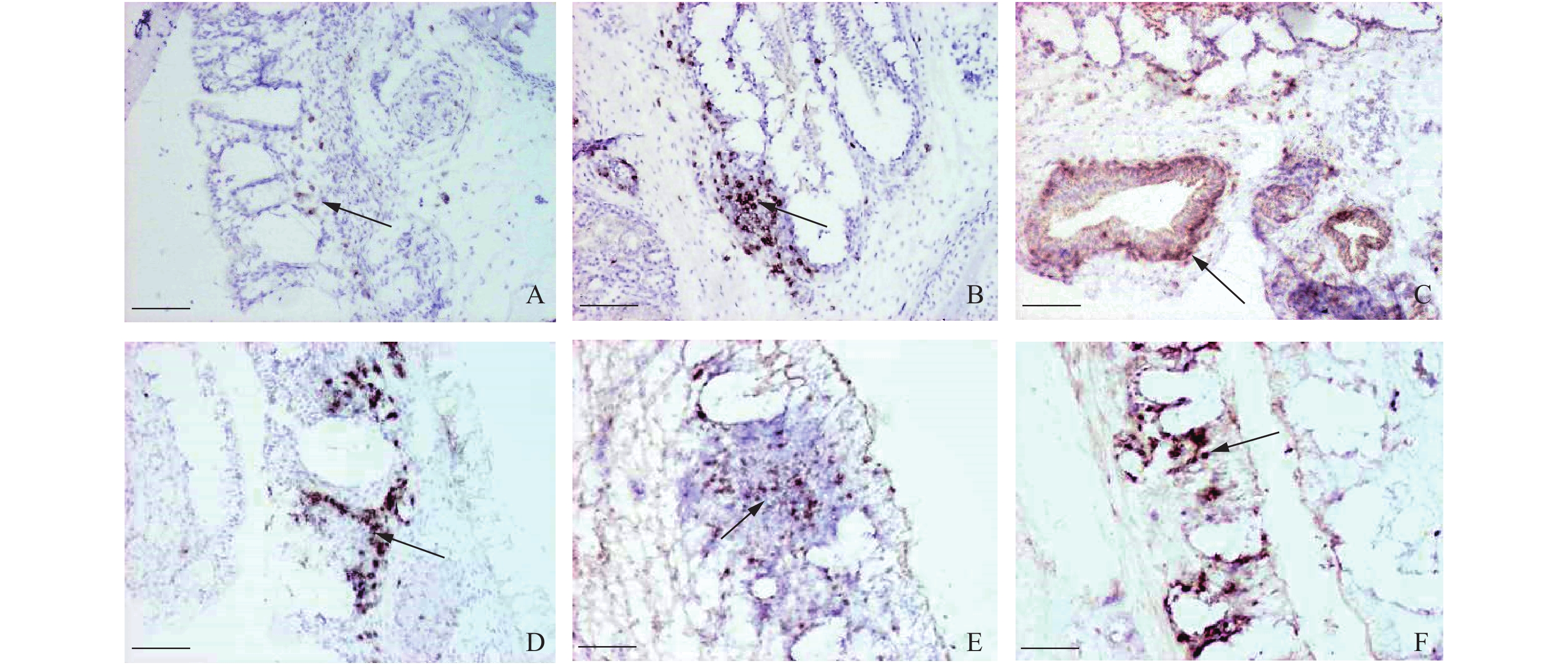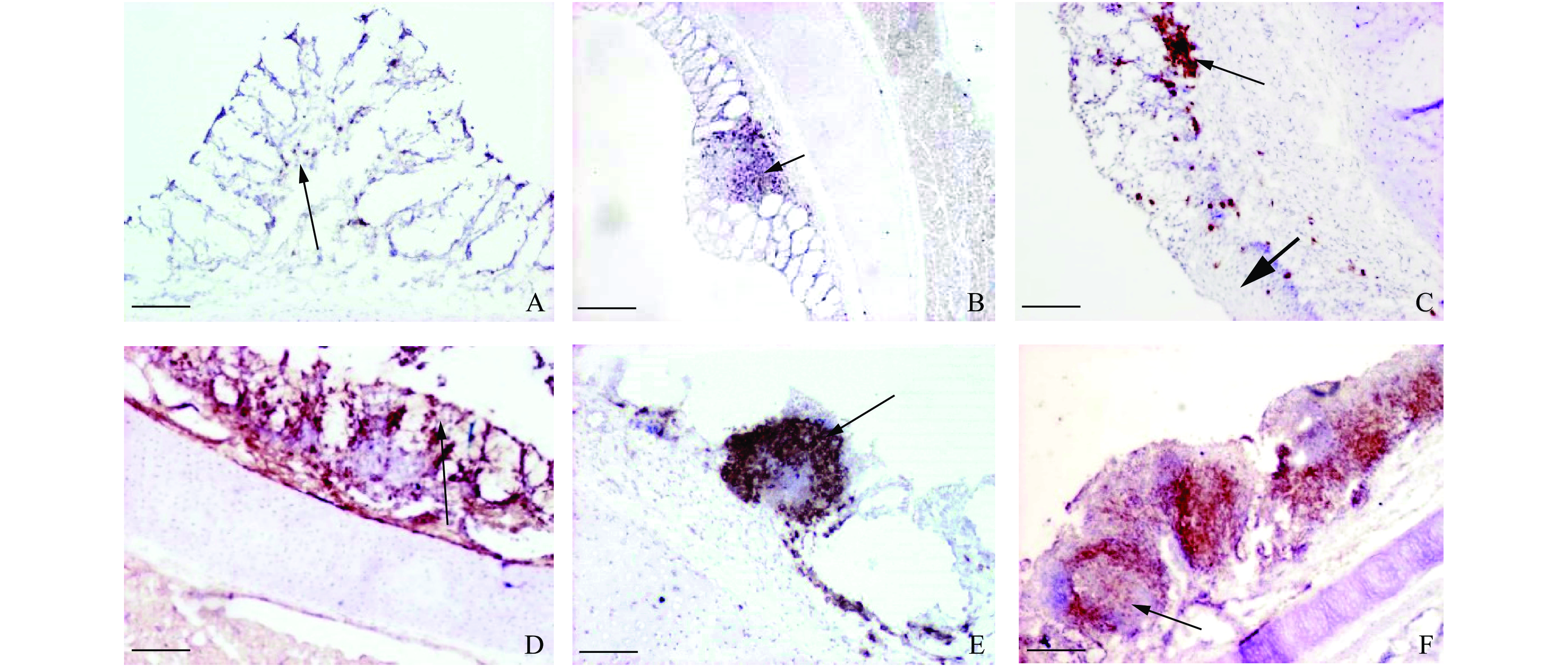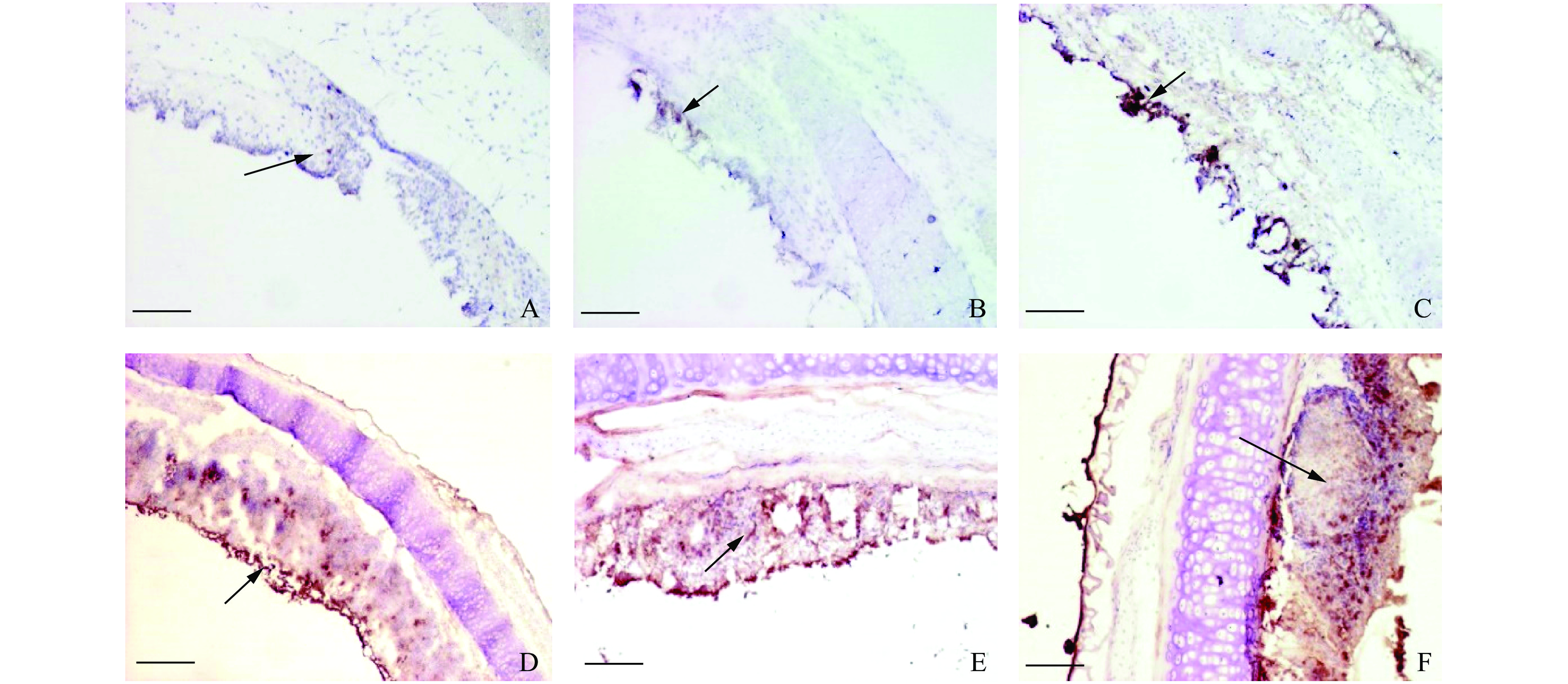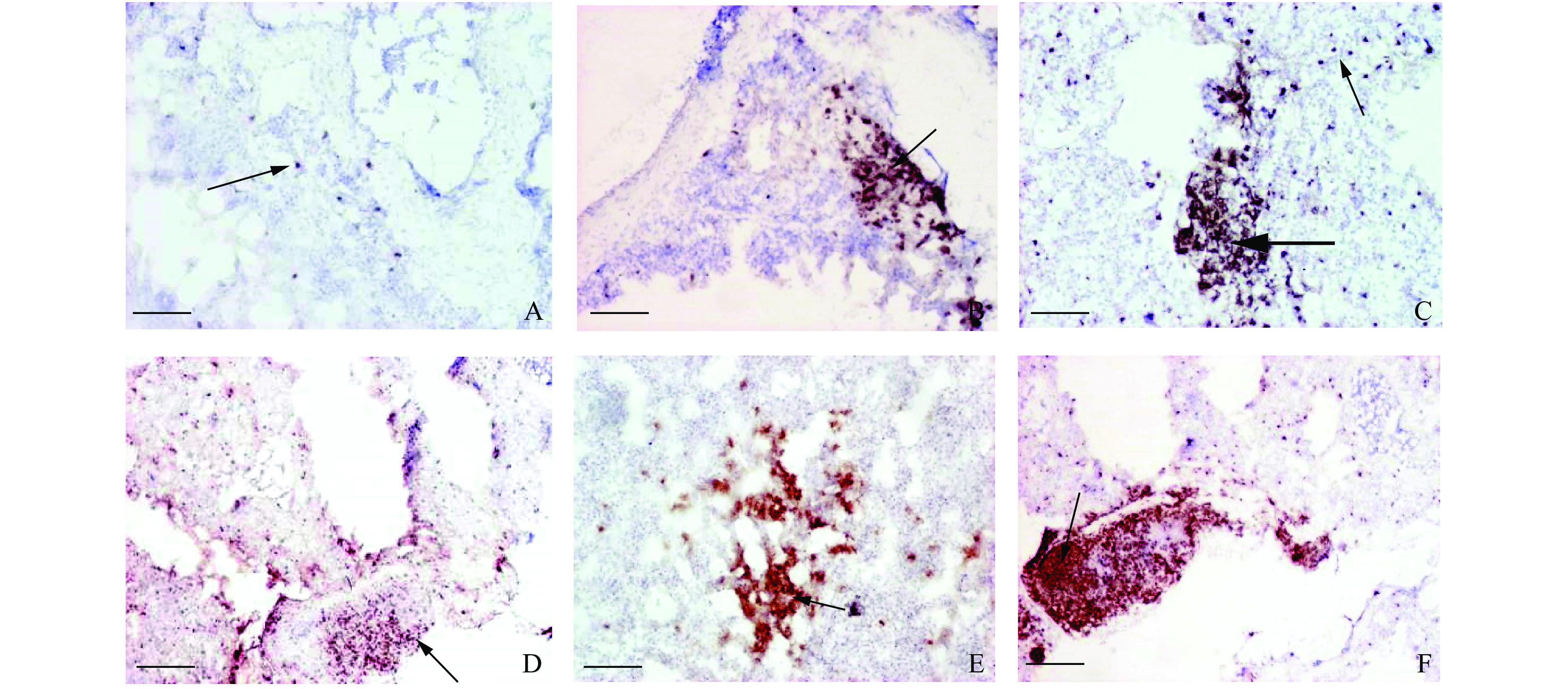Distribution of IgA secreting cells in respiratory mucosa of chicken at different day-age
-
摘要:目的
了解鸡呼吸道黏膜不同时期的免疫状态。
方法选择海兰白鸡鸡胚(18、20 日龄)及不同日龄(1、4、7、14、21、35和56 日龄)雏鸡的鼻、喉、气管和肺脏样品,利用免疫组织化学方法研究IgA+分泌细胞的出现、定位分布及数量变化过程。
结果呼吸道各个器官黏膜中胚胎时期均没有IgA+细胞出现,鼻和肺脏中1日龄时出现,喉黏膜中4日龄时出现,而气管黏膜中7日龄时才出现。随着日龄增长,各器官呼吸道黏膜中IgA+细胞数量均逐渐增加。鼻黏膜以及肺脏初级支气管和次级支气管交叉处4日龄时较早地形成淋巴聚集物,喉黏膜中7日龄时形成,气管黏膜中35日龄时形成。在这些淋巴聚集物中IgA+细胞均主要分布于淋巴聚集物的外周。35日龄时,在鼻、喉和气管黏膜固有层以及上皮内均存在较多的IgA+细胞,从而能够更有效和直接地分泌SIgA,执行黏膜免疫功能。56日龄时,4种器官的呼吸道黏膜中IgA+细胞的数量达到峰值,并在黏膜底部形成生发中心,具有了黏膜相关性淋巴组织的典型特征,从而更有效地执行黏膜免疫功能。
结论鸡呼吸道黏膜中IgA+细胞的分布和数量均呈现日龄相关性变化,并且在35日龄时,鼻、喉、气管和肺脏中IgA+细胞数量和分布部位均达到一定规模,能够为呼吸道黏膜提供免疫保护。
Abstract:ObjectiveTo understand the immune status of chicken respiratory mucosa at different stages.
MethodThe embryo of Hy-line white chickens (18- and 20-day-old), and the nose, larynx, trachea and lung of chickens at different day-age (1-, 4-, 7-, 14-, 21-, 35- and 56-day-old) were selected in this study. The occurrence, location, distribution and quantity change of IgA+ secreting cells were studied by immunohistochemical method.
ResultThere was no IgA+ cell in the mucosa of each respiratory organ during the embryonic period. IgA+ cells were present in the nose and lung at 1-day-old age, laryngeal mucosa at 4-day-old age, and tracheal mucosa at 7-day-old age. The number of IgA+ cells in the respiratory mucosa of each organ increased gradually with the increase of age. The lymphoid aggregates were formed earlier in the nasal mucosa and the intersections of the primary and secondary bronchus in the lung at 4-day-old age, and formed in the laryngeal mucosa at 7-day-old age, in the tracheal mucosa at 35-day-old age. The IgA+ cells in these lymphoid aggregates were all mainly distributed on the periphery of the lymphoid aggregates. At 35-day-old age, there were more IgA+ cells in the mucosal lamina propria and the epithelium of the nose, larynx and trachea, and thus more effective and direct secretion of SIgA could be performed for mucosal immunity. At 56-day-old age, the number of IgA+ cells in the respiratory mucosa of the four organs reached a peak and germinal centers were formed at the mucosal bottom, which was the characteristic of mucosal associated lymphoid tissue, thus more effectively performed mucosal immune function.
ConclusionThe distribution and number of IgA+ cells in the respiratory mucosa of chickens show age-related changes, and the number and distribution of IgA+ cells in the nose, larynx, trachea and lung all reach a certain scale at 35-day-old, which can provide immune protection for the respiratory mucosa.
-
Keywords:
- chicken /
- respiratory mucosa /
- IgA+ secreting cells /
- distribution characteristic /
- mucosal immune
-
紫色马铃薯原产于南美洲,其果皮和果肉呈现紫色至黑色,较普通马铃薯含有更高的花青素等抗氧化成分,具有抗氧化、抗衰老、降脂等重要保健功能[1]。随着我国马铃薯主食加工技术的开发和成熟,作为主食加工的主要原料,马铃薯全粉的市场需求趋旺。冻融固液分离法是制备马铃薯全粉的一种方法,主要通过冻融离心分离去除薯泥中大部分的水分,缩短薯泥干燥环节消耗的时间,具有能耗低、全粉细胞破损率低等优势[2-3]。但该工艺离心环节会产生30%~35%的汁液副产物,其含有丰富的碳水化合物、游离氨基酸等营养成分及Patatin糖蛋白、多酚和花色苷等活性成分[4-9],具有较强的再加工利用潜力。然而目前因缺乏成熟的转化利用技术,该工艺产生的马铃薯汁液只能直接或经处理后排放,不仅导致了资源的严重浪费,也产生了严重的环境污染问题。因此有必要对该工艺的冻融分离汁液副产物进行再转化利用,解决汁液排放带来的环保问题,提高资源利用率,延伸马铃薯产业链,增加附加值。
作为世界第一大啤酒生产和消费国,中国国产啤酒产品结构单一、口味淡薄、同质化严重,随着消费的逐步转型和升级,其已无法满足多元化、个性化和高端化的消费需求[10]。近几年来,个性风格突出、具有保健功能的啤酒新产品逐渐成为市场的新宠,已有利用蓝莓汁[11]、红枣[12]、香蕉[13]、樱桃[14]、可可浆[15]等作为辅料,添加入麦芽汁中发酵不同类型保健啤酒的研究报道。薯类含有丰富的淀粉,已被不少研究者作为添加辅料用于发酵薯酒饮料[16-17]。Panda等[18]将紫甘薯泥作为辅料发酵富含花青素的啤酒,结果表明添加30%(w)的紫甘薯所酿造的啤酒风味最好,且具有较强的DPPH清除活性。本试验将紫色马铃薯全粉加工过程中产生的冻融分离汁液用酶解糖化处理后,添加到麦芽汁中发酵浓色啤酒。对酶解汁液添加量、pH、温度等发酵条件进行优化,并分析所酿造啤酒的主要抗氧化成分及含量,评价其体外抗氧化活性,以期为利用紫色马铃薯汁液发酵富含花青素的浓色啤酒提供技术参考,促进马铃薯冻融分离汁液的资源化利用。
1. 材料与方法
1.1 材料
紫色马铃薯‘黑金刚’,产自甘肃陇西;大麦芽(浓香琥珀麦芽、焦香麦芽、欧麦淡色艾尔麦芽)、啤酒花颗粒(布兰科),均购自超级麦芽(北京)贸易有限公司;啤酒酵母(M20、M21、M36、M44、M47),Mangrove Jack’s公司生产,购自超级麦芽(北京)贸易有限公司;α−淀粉酶(5万U/g)、糖化酶(5万U/g),购自北京索莱宝科技有限公司;麦芽糖浆购自蕲春县天利生物工程有限公司。
3,5−二硝基水杨酸(分析纯)购自成都市科隆化学品有限公司;Folin-Ciocalteu试剂购自北京索莱宝科技有限公司;没食子酸标准品、绿原酸标准品、1,1−二苯基−2−三硝基苯肼(DPPH)、2,2'−联氮−双−3−乙基苯并噻唑啉−6−磺酸(ABTS)购自南京都莱生物技术有限公司。
CPA225D型电子天平,德国赛多利斯股份公司;YXQ-LS-50SII高压蒸汽灭菌锅,上海博讯实业有限公司;SS300-N食品工业用离心机,张家港市永泰阳光机械制造有限公司;ST16R冷冻离心机,美国Thermo公司;PHS-4C+型酸度计,成都世纪方舟科技有限公司;UV-3100PC型紫外分光光度仪计,上海美谱达仪器有限公司;LB-20T型折光仪,深圳市汇科计量检测技术有限公司;HZQ-X100A型恒温振荡培养箱,上海一恒科学仪器有限公司;DK-8D型电热恒温水槽,上海齐欣科学仪器有限公司;SHP-160型智能生化培养箱,上海三发科学仪器有限公司。
1.2 方法
1.2.1 啤酒发酵工艺流程
清洗马铃薯、切片、蒸汽熟化、冷冻、解冻、离心等步骤制备马铃薯全粉,收集离心产生的汁液。采用双酶水解法酶解糖化马铃薯汁液,每100 mL汁液添加0.8 g α−淀粉酶和1.0 g糖化酶,糖化温度为70 ℃,糖化时间为1 h,pH 5.0,糖化结束后煮沸5 min灭活并过滤。经测定,酶解汁液还原糖为19.57 mg/mL,α−氨基氮为360.6 μg/mL,花青素为1.38 mg/mL,总酚为296.5 μg/mL。
取破碎麦芽,将焦香麦芽、浓香琥珀麦芽、欧麦淡色艾尔麦芽按照质量比1∶2∶3混合,添加4倍质量的水,调pH至5.5。糖化程序:45 ℃ 30 min;60 ℃ 60 min;72 ℃10 min;78 ℃ 10 min;迅速降温至45 ℃,趁热滤布过滤,并添加浓缩麦芽糖浆调整麦芽汁浓度至16°P。经测定,还原糖为103.5 mg/mL,α−氨基氮为121.2 μg/mL,总酚为409.0 μg/mL。
向酶解糖化麦芽汁中添加一定体积的糖化马铃薯汁液,并混合均匀。将混合汁液煮沸15 min后,按0.12 g/L添加啤酒花,继续煮沸30 min,再按0.28 g/L添加啤酒花。
酵母种子液的制备:取活化的斜面菌种接种于10 mL 12°P麦芽汁中,28 ℃培养36 h,再转接种于10 mL 12°P麦芽汁中,20 ℃培养36 h,再转接种于200 mL 12°P麦芽汁中,15 ℃培养24~36 h,得到种子液,其酵母细胞数量为1×107 mL−1。
采用下面酵母发酵法进行主发酵,接种啤酒酵母种子液,恒温发酵至24 h质量损失不超过0.2 g,即为发酵终点。主发酵结束后缓慢降温至0 ℃,经过7 d的后熟及饱和CO2处理。采用4000 r/min离心15 min,过滤分离即得啤酒。啤酒发酵工艺流程图见图1。
1.2.2 啤酒发酵单因素试验
主要考察马铃薯酶解汁液添加体积分数(0、25%、33%、50%、67%、75%)、初始pH(5.0、5.5、6.0、6.5、7.0)、酵母接种体积分数(2%、4%、6%、8%、10%)、发酵温度(10、12、15、18、22 ℃)和酵母种类(M20、M21、M36、M44、M47)对啤酒发酵过程主要指标的影响,各因素试验固定水平分别为:马铃薯酶解汁液添加体积分数50%,初始pH 6.0,酵母接种体积分数6.0%,发酵温度15 ℃,酵母种类M21。取150 mL混合汁置于250 mL三角瓶,接种啤酒酵母进行发酵。采用模糊数学评定法对后发酵结束的样品进行感官评价,测定发酵液的发酵度、酒精度、还原糖含量、总酸、pH、色泽等理化指标。
1.2.3 啤酒发酵条件正交试验优化
根据单因素试验结果,选取对啤酒指标影响最大的3个因素:马铃薯酶解汁液添加体积分数、pH和温度,以啤酒感官评分及酒精度为指标,采用L9(34)正交试验进行发酵工艺优化,因素及水平见表1。
表 1 啤酒发酵条件正交试验因素水平Table 1. Factors and levels of orthogonal experiment for beer fermentation conditions水平 Level 因素 Factor 紫色马铃薯酶解汁液添加体积分数/%
Addition of purple potato enzymolysis juice (A)pH(B) θ/℃ (C) 1 75 5.0 12 2 50 5.5 15 3 25 6.5 18 1.2.4 啤酒感官评定
由10名食品感官评定专业人员组成评定小组,对啤酒的色泽、泡沫、香气、杀口和口味进行感官评定,并设4个等级:优、良、中和差。评价为优的啤酒色泽暗红、酒体澄清透明;泡沫丰富、细腻,挂杯持久性好;麻舌感强烈,有明显的舒适、新鲜、刺激感;口味纯正、爽口、醇厚;有明显的酒花芳香,无异香。评价为良的啤酒色泽暗红、较透明;泡沫较丰富细腻,挂杯持久性较好;舒适、新鲜、刺激的感觉较为明显;口味纯正、较爽口、较醇厚;有较明显的酒花芳香。评价为中的啤酒色泽较浅、微浑浊;泡沫少,挂杯持久性差;较新鲜,刺激感较差;口味单薄,不爽口;无明显的酒花芳香。评价为差的啤酒色泽浅、明显浑浊状;无舒适、新鲜、刺激感;口味很单薄,不爽口;有其他异味。以色泽、泡沫、杀口、口味、香气为因素集,以好、较好、一般、差为评语集,根据感官评定结果,建立4个单因素评价矩阵,用模糊数学评定方法对其进行分析。因素集U={色泽,泡沫,香气,杀口,口味};评语集V={好,较好,一般,差};其中,好(100分),较好(80分),一般(70分),差(60分)。权重集X={0.15,0.20,0.20,0.30,0.15},色泽15分,泡沫20分,杀口20分,口味30分,香气15分,共100分。模糊关系综合评定集Y=XR,其中X为权重集,R为模糊矩阵。
1.2.5 啤酒理化指标测定
还原糖含量采用3,5−二硝基水杨酸比色法测定[19];发酵度、酒精度、色度、总酸含量均采用GB/T 4928—2008《啤酒分析方法》[20]测定;pH采用酸度计测定。
1.2.6 啤酒抗氧化成分及体外活性测定
总多酚含量测定采用Folin-Ciocalteu法[21];绿原酸含量测定采用比色法[22];花青素含量测定采用pH示差法[23];总抗氧化能力测定采用ABTS法[22];DPPH自由基清除率测定采用比色法[24],总还原力测定采用铁离子还原法(FRAP)[25]。
1.3 数据处理
运用Office Excel 2010对数据进行处理及方差分析,差异显著性分析用Duncan’ s新复极差法。
2. 结果与分析
2.1 发酵单因素试验结果
2.1.1 酶解汁液添加体积分数
由表2可知,与纯麦芽汁啤酒(CK)相比,添加不同体积分数的紫色马铃薯酶解汁液均降低了发酵啤酒的酒精度、提高了发酵啤酒的pH,但随着酶解汁液添加体积分数的增加,啤酒酒精度、色度、发酵度和pH均呈降低趋势,而还原糖含量、总酸含量呈逐渐增加趋势。表明啤酒酵母对紫色马铃薯酶解汁液的利用转化能力弱于麦芽汁,这与马铃薯酶解汁液中α−氨基氮含量较高,而还原糖含量较低有关[26]。紫色马铃薯酶解汁液添加体积分数为25%~50%较为适宜,综合感官评分均在80以上,其中酶解汁液添加体积分数为25%时发酵的啤酒感官综合评分为88.0,且酒精度、发酵度较高,分别为4.28%和56.47%。
表 2 紫色马铃薯酶解汁液添加体积分数对浓色啤酒感官评分及理化指标的影响1)Table 2. Effects of potato enzymolysis juice addition on sensory score and physicochemical properties of dark beerφ(紫色马铃薯
酶解汁液)/%
Addition of purple potato enzymolysis juice感官评分
Sensory
score酒精度(φ)/%
Alcohol contentρ(还原糖)/
(mg·mL−1)
Reducing sugar content色度/EBC
Chromaφ(总酸)/
(mL·L−1)
Total acidspH 发酵度/%
Fermentative degree发酵力/
(g·L−1·d−1)
Fermentation capacity0(CK) 85.8 4.48±0.03a 32.53±4.89a 34.83±0.25ab 12.8±0.3a 4.17 60.87 6.85 25 88.0 4.28±0.02b 9.96±0.02f 34.35±0.26b 7.9±0.1c 4.81 56.47 6.09 33 84.8 4.23±0.04b 10.10±0.03e 35.04±0.20a 8.1±0.1c 4.74 53.85 5.41 50 80.5 4.11±0.05c 11.16±0.03c 30.84±0.15d 9.1±0.3b 4.54 52.43 4.26 67 76.6 3.14±0.03d 10.37±0.02d 27.23±0.20e 9.3±0.4b 4.33 50.32 3.21 75 72.2 3.08±0.05d 12.59±0.03b 20.19±0.20c 9.4±0.4b 4.25 48.89 3.21 1)同列数据后的不同小写字母表示差异显著(P<0.05,Duncan’s法)
1)Different lowercase letters in the same column indicate significant differences (P<0.05,Duncan’s test)2.1.2 初始pH
由表3可知,随着发酵初始pH的增加,啤酒样品酒精度、还原糖含量、色度、总酸和发酵度均呈下降趋势。相对较高的pH不利于乙醇发酵,不能利用酵母代谢产生更多的有机酸成分。较适宜的发酵初始pH范围为5.0~6.5,其中pH为6.0时,综合感官评分最高,为85.4;酒精度在pH为6.5时最高,为4.66%,发酵度则在pH为5.0时最高,为66.15%。
表 3 不同初始pH对浓色啤酒感官评分及理化指标的影响1)Table 3. Effects of initial pH on sensory score and physicochemical properties of dark beer初始 pH
Initial pH感官评分
Sensory score酒精度(φ)/%
Alcohol contentρ(还原糖)/
(mg·mL−1)
Reducing sugar content色度/EBC
Chromaφ(总酸)/
(mL·L−1)
Total acidspH 发酵度/%
Fermentative degree发酵力/
(g·L−1·d−1)
Fermentation capacity5.0 82.6 4.49±0.04b 18.92±0.15a 39.50±0.20a 9.7±0.1a 4.67 66.15 4.67 5.5 83.2 4.26±0.04d 18.64±0.20a 38.88±0.10ac 9.7±0.1a 4.69 63.08 4.76 6.0 85.4 4.53±0.03c 13.96±0.20b 38.29±0.20bc 9.4±0.1b 4.68 64.62 4.85 6.5 82.3 4.66±0.02a 8.61±0.21c 34.88±0.15e 8.2±0.1c 4.73 65.38 5.18 7.0 80.2 4.63±0.05a 5.75±0.31d 36.52±0.20d 8.0±0.1d 4.66 61.52 5.22 1)同列数据后的不同小写字母表示差异显著(P<0.05,Duncan’s法)
1)Different lowercase letters in the same column indicate significant differences (P<0.05,Duncan’s test)2.1.3 酵母菌株
由表4可知,不同酵母菌株对啤酒发酵的各项指标影响不同。M20发酵的啤酒酒精度相对较高;M36发酵的啤酒还原糖含量最低,发酵度、色度最高;而各组样品的总酸含量则没有明显差别。这表明M36会更多地利用还原糖进行繁殖,乙醇转化能力较弱。酵母菌株选用M21或M20较适宜,综合感官评分较高。其中选用M21酵母时,发酵的啤酒综合评分为86.3,且酒精度、发酵度较高,分别为4.25%和53.08%。
表 4 不同酵母菌种对浓色啤酒感官评分及理化指标的影响1)Table 4. Effects of yeast strains on sensory score and physicochemical properties of dark beer酵母菌株
Yeast starter感官评分
Sensory score酒精度(φ)/%
Alcohol contentρ(还原糖)/
(mg·mL−1)
Reducing sugar content色度/EBC
Chromaφ(总酸)/
(mL·L−1)
Total acidspH 发酵度/%
Fermentative degree发酵力/
(g·L−1·d−1)
Fermentation capacityM20 84.3 4.49±0.00a 15.18±0.05b 36.06±0.06b 9.5±0.3a 4.56 51.54 5.84 M21 86.3 4.25±0.00b 13.47±0.03c 35.66±0.11c 9.5±0.2a 4.53 53.08 5.54 M36 80.8 4.26±0.00b 8.70±0.02e 37.21±0.35a 9.1±0.3a 4.61 60.38 5.83 M44 84.1 4.24±0.00b 15.72±0.03a 34.94±0.26d 10.5±2.1a 4.34 47.31 4.66 M47 81.6 4.17±0.00c 12.92±0.04d 33.17±0.10e 9.1±1.0a 4.62 53.08 5.74 1)同列数据后的不同小写字母表示差异显著(P<0.05,Duncan’s法)
1)Different lowercase letters in the same column indicate significant differences (P<0.05,Duncan’s test)2.1.4 酵母接种量
由表5可知,随着酵母接种量(φ)的增加,啤酒样品酒精度和发酵度均呈下降趋势,而还原糖含量、色度呈上升趋势,总酸和pH则无明显变化。结果表明啤酒酵母接种量越多,其用于繁殖的糖就越多,产生酒精的量就越少。初始酵母接种量(φ)为2%~6%较为适宜,综合感官评分较高,其中酵母接种量(φ)为6%时发酵的啤酒综合评分为87.2,且酒精度、发酵度较高,分别为5.01%和60.38%。
表 5 不同酵母接种体积分数对浓色啤酒感官评分及理化指标的影响1)Table 5. Effects of yeast inoculation doses on sensory score and physicochemical properties of dark beerφ(酵母接种)/%
Yeast inoculation
dosage感官评分
Sensory score酒精度(φ)/%
Alcohol contentρ(还原糖)/
(mg·mL−1)
Reducing
sugar content色度/EBC
Chromaφ(总酸)/
(mL·L−1)
Total acidspH 发酵度/%
Fermentative degree发酵力/
(g·L−1·d−1)
Fermentation capacity2 82.1 5.84±0.00a 9.39±0.04c 33.24±0.15c 10.1±0.2a 4.57 61.54 6.06 4 85.1 5.09±0.00c 9.25±0.03d 32.18±0.10d 9.7±0.1a 4.64 61.15 6.20 6 87.2 5.01±0.00d 9.41±0.04c 33.01±0.20c 9.6±0.2a 4.64 60.38 6.19 8 81.2 4.83±0.00e 11.01±0.12a 34.02±0.15a 9.1±0.9a 4.61 60.38 6.53 10 78.5 5.33±0.00b 10.14±0.03b 33.60±0.15b 9.6±1.4a 4.51 59.62 7.80 1)同列数据后的不同小写字母表示差异显著(P<0.05,Duncan’s法)
1)Different lowercase letters in the same column indicate significant differences (P<0.05,Duncan’s test)2.1.5 发酵温度
由表6可知,随着主发酵温度的升高,啤酒样品酒精度均呈先升后降趋势,而还原糖含量、色度呈下降趋势,且色度间差异显著,但pH、发酵度间无显著差异。在一定范围之内,酵母的代谢活动随着温度的升高而加快,酒精的产量也随之增加,产品风味逐渐变得丰满。发酵温度过高,酵母代谢活动受到抑制,酒精产量反而下降,甲醇和杂醇油等发酵副产物含量增多[27],导致原酒品质变差。主发酵温度为12~18 ℃较为适宜,综合感官评分较高,其中15 ℃发酵的啤酒综合评分为86.3,且酒精度、发酵度最高,分别为4.85%和60.77%。
表 6 不同发酵温度对浓色啤酒感官评分及理化指标的影响1)Table 6. Effects of fermentation temperatures on sensory score and physicochemical properties of dark beer发酵温度/℃
Fermentation temperature感官评分
Sensory score酒精度(φ)/%
Alcohol contentρ(还原糖)/
(mg·mL−1)
Reducing
sugar content色度/EBC
Chromaφ(总酸)/
(mL·L−1)
Total acidspH 发酵度/%
Fermentative degree发酵力/
(g·L−1·d−1)
Fermentation capacity10 85.1 4.62±0.00d 11.65±0.02a 39.80±0.20a 10.4±0.5a 4.71 55.38 5.52 12 84.8 4.59±0.00e 8.83±0.04b 38.42±0.15b 9.7±0.1ab 4.70 60.38 5.67 15 86.3 4.85±0.00a 8.59±0.02c 37.96±0.15b 9.1±0.2b 4.85 60.77 8.87 18 84.1 4.79±0.00b 8.77±0.02b 36.45±0.20c 9.3±1.0ab 4.46 60.77 6.53 22 76.2 4.65±0.00c 8.59±0.03c 34.97±0.20d 8.9±0.9b 4.71 60.38 5.50 1)同列数据后的不同小写字母表示差异显著(P<0.05,Duncan’s法)
1)Different lowercase letters in the same column indicate significant differences (P<0.05,Duncan’s test)2.2 添加紫色马铃薯酶解汁液的啤酒发酵正交试验结果
根据单因素试验结果,选取紫色马铃薯酶解汁液添加体积分数(A)、发酵pH (B)、发酵温度(C)为因素,采用L9(34)正交试验进行糖化工艺优化,结果见表7。由表7可知,试验因素对添加紫色马铃薯酶解汁液的啤酒感官评分的影响顺序为pH(B)>发酵温度(C)>酶解汁液添加体积分数(A),最优水平组合为A3B3C2,即紫色马铃薯酶解汁液添加量(φ)为25%,初始pH为6.5,15 ℃条件下发酵10 d的啤酒感官评分最高(86.9),且酒液呈琥珀色、晶莹剔透,酒香协调、入口柔顺,色度为37.71 EBC,还原糖为18.69 mg/mL,酒精度为5.84%,pH为 5.01,残糖度为9.53°Bx,总酸为15.6 mL/L,符合国标GB 4927—2008《啤酒》[28]相关指标要求。
表 7 添加紫色马铃薯酶解汁液的浓色啤酒发酵正交试验结果Table 7. Results of orthogonal experiment for dark beer fermentation with addition of purple potato enzymolysis juice试验号
Experiment No.A B C 误差
Error感官评分
Sensory score1 1 1 1 1 73.2 2 1 2 2 2 78.8 3 1 3 3 3 79.6 4 2 1 2 3 78.7 5 2 2 3 1 68.8 6 2 3 1 2 83.7 7 3 1 3 2 75.0 8 3 2 1 3 81.5 9 3 3 2 1 86.9 k1 72.150 70.603 74.450 71.250 k2 72.050 71.333 76.433 74.137 k3 76.103 78.367 69.420 74.917 极差 Range 4.053 7.764 7.013 3.667 2.3 添加紫色马铃薯酶解汁液浓色啤酒的抗氧化成分含量
采用最优工艺条件制备的紫色马铃薯浓色啤酒,与市售浓色啤酒中的主要抗氧化成分含量进行比较。由表8可知,纯麦芽浓色啤酒及市售浓色啤酒未检出花青素成分。与纯麦芽浓色啤酒及市售浓色啤酒相比,本研究制备的紫色马铃薯浓色啤酒总酚、绿原酸含量显著提高,并含有丰富的来自于马铃薯酶解汁液的花青素成分,总酚、绿原酸和花青素含量分别为360.2、685.7和208.4 mg/L。其中总酚和绿原酸含量分别为市售产品含量的2.90和1.14倍。与未发酵混合汁液相比,添加紫色马铃薯酶解汁液浓色啤酒的总酚含量显著提高,可能与发酵过程中酚类物质的部分释放有关[29];绿原酸和花青素含量减少表明其在发酵过程中的稳定性较差,但在最后的啤酒中其含量仍高于市售产品。因此,添加紫色马铃薯酶解汁液可以赋予浓色啤酒更多的抗氧化物质。
表 8 添加紫色马铃薯酶解汁液的浓色啤酒与市售浓色啤酒抗氧化成分含量比较1)Table 8. Contents of antioxidants in commercial dark beer and dark beer with addition of purple potato enzymolysis juice样品
Sampleρ/(mg·L−1) 总酚 Total phenol 绿原酸 Chlorogenic acid 花青素 Anthocyanin 添加紫色马铃薯酶解汁液的浓色啤酒
Dark beer with addition of purple potato enzymolysis juice360.2±3.9a 685.7±11.6c 208.4±6.0b 未发酵混合汁液 Mixture juice before fermentation 352.7±1.8b 1104.9±7.9a 691.3±23.1a 纯麦芽浓色啤酒 Dark beer prepared with pure wort 186.0±1.5c 1020.0±41.9b 0 某市售浓色啤酒 A commercial dark beer 124.2±2.8d 602.1±24.4d 0 1)同列数据后的不同小写字母表示差异显著(P<0.05,Duncan’s法)
1)Different lowercase letters in the same column indicate significant differences (P<0.05,Duncan’s test)2.4 添加紫色马铃薯酶解汁液浓色啤酒的体外抗氧化能力
选择最优发酵条件制备的添加紫色马铃薯酶解汁液的浓色啤酒,将其稀释10倍后进行体外抗氧化活性评价。由表9可知,与纯麦芽浓色啤酒及市售浓色啤酒相比,添加25%(φ)紫色马铃薯酶解汁液发酵制备的浓色啤酒具有更高的体外抗氧化能力。样品10倍稀释液总还原力与0.150 mg/mL维生素C溶液相当,分别为纯麦芽浓色啤酒和市售浓色啤酒的1.80和2.80倍;DPPH自由基清除率为49.9%,与0.043 mg/mL 维生素C溶液清除能力相当,分别为纯麦芽浓色啤酒和市售浓色啤酒的1.06和1.44倍;ABTS自由基清除率为83.9%,分别为纯麦芽浓色啤酒和市售浓色啤酒1.13和1.20倍。综合各抗氧化指标,添加25%(φ)紫色马铃薯酶解汁液可赋予浓色啤酒更强的体外抗氧化活性。与未发酵混合汁液相比,紫色马铃薯浓色啤酒DPPH自由基清除率略有下降,可能与啤酒酵母细胞在发酵过程中吸附花青素等抗氧化成分有关[30]。
表 9 添加紫色马铃薯酶解汁液的浓色啤酒与市售浓色啤酒体外抗氧化能力比较1)Table 9. Comparison of antioxidant capacities in vitro between commercial dark beer and dark beer with addition of purple potato enzymolysis juice样品
Sample总还原力
Total reduction capacityDPPH自由基清除能力
DPPH radical scavenging capacityABTS自由基
清除率/%
ABTS radical scavenging rate还原值
Reduction
valueρ(维生素C)/
(mg·mL−1)
Vitamin C content清除率/%
Scavenging
rateρ(维生素C)/
(mg·mL−1)
Vitamin C
content添加紫色马铃薯酶解汁液的浓色啤酒
Dark beer with addition of purple potato enzymolysis juice0.9509±0.022 4a 0.150±0.016a 49.9±0.6b 0.043±0.003b 83.9±2.3a 未发酵混合汁液
Mixture juice before fermentation0.9138±0.006 5b 0.143±0.019a 55.3±0.8a 0.048±0.004a 37.0±3.3c 纯麦芽浓色啤酒
Dark beer prepared with pure wort0.5259±0.006 8c 0.074±0.019b 46.8±0.5c 0.040±0.003c 74.0±3.4b 某市售浓色啤酒 A commercial dark beer 0.3460±0.001 8d 0.042±0.020c 34.6±0.5d 0.028±0.003d 69.9±1.3b 1)同列数据后的不同小写字母表示差异显著(P<0.05,Duncan’s法)
1)Different lowercase letters in the same column indicate significant differences (P<0.05,Duncan’s test)3. 讨论与结论
紫色马铃薯冻融分离汁液作为马铃薯全粉冻融制备工艺的加工副产物,含有丰富的碳水化合物等营养物质成分及花青素、多酚等功能活性成分,具有较强的再加工转化及利用的潜力。目前对于该副产物的开发利用尚处于初步探索阶段,鲜见相关产品开发的研究报道。薯类含有大量淀粉,对酿制啤酒用大米等发酵辅料具有很强的替代潜力。张赟彬等[31]研究表明,添加马铃薯粉作为辅料可酿造高氨基酸营养深色啤酒,且各项指标均符合国家标准的要求。姚立华等[32]采用两次喂饭法,以新鲜马铃薯为辅料进行黄酒酿造的研究,结果表明,所酿造的黄酒符合国家黄酒标准,且游离氨基酸含量是普通黄酒的1.2~2.5倍。紫色马铃薯冻融分离汁液除了含有一定量的可发酵糖类物质外,还有丰富的花青素和多酚。本研究将紫色马铃薯酶解汁液作为辅料加入麦芽汁中,探讨添加马铃薯酶解汁液发酵较强抗氧化活性浓色啤酒的可行性。结果表明,添加紫色马铃薯酶解汁液可作为辅料发酵具特色风味的浓色啤酒。但在试验中发现,啤酒酵母对马铃薯酶解汁液的转化利用能力弱于麦芽汁,添加过多的马铃薯酶解汁液会导致发酵度下降。这可能与紫色马铃薯酶解汁液中碳水化合物组成与麦芽汁差异有关,将其加入麦芽汁改变了可发酵糖及α−氨基氮的含量及组成。因此,下一步将对紫色马铃薯酶解汁液碳水化合物、氨基酸种类及其含量进行分析,通过外源添加优化碳氮源以提高紫色马铃薯啤酒的发酵度。另一方面,还可通过筛选适合紫色马铃薯酶解汁液发酵的啤酒酵母菌种,进一步减少麦芽汁用量,提高发酵浓色啤酒的综合质量。
紫色马铃薯全粉分离酶解汁液制备浓色啤酒的最佳主发酵条件为:混合麦芽汁浓度16°P,紫色马铃薯酶解汁液添加体积分数为25%,初始pH 6.5,M21酵母接种量(φ)为2%,15 ℃发酵10 d,所得浓色啤酒色泽晶莹、色若琥珀,酒香协调、入口柔顺,酒精度为5.83%,感官评分86.9分,还原糖为18.69 mg/mL,色度为37.71 EBC,总酸为15.6 mL/L,均符合国标相关指标要求。酿造的紫色马铃薯浓色啤酒含有总酚、绿原酸和花青素等抗氧化成分,具有较强的体外抗氧化活性。
-
图 1 不同日龄鸡鼻黏膜中IgA+分泌细胞的分布情况
A:1日龄(箭头指向鼻后孔鼻腔侧黏膜下的IgA+细胞),B:4日龄(箭头指向鼻黏膜相关性淋巴组织中的IgA+细胞),C:4日龄(箭头指向鼻腺周围的IgA+细胞),D:7日龄(箭头指向鼻黏膜相关性淋巴组织中的IgA+细胞),E:21日龄(箭头指向鼻黏膜相关性淋巴组织中的IgA+细胞),F:35日龄(箭头指向柱状皱襞固有层中的IgA+细胞);标尺=100 μm
Figure 1. Distribution of IgA+ secreting cells in the nasal mucosa of chicken at different day-age
A: 1-day-old (arrow points to IgA+ cells in the submucosa of the nasal cavity in the posterior nasal foramen), B: 4-day-old (arrow points to IgA+ cells in the associated lymphoid tissue of nasal mucosa), C: 4-day-old (arrow points to IgA+ cells around the nasal glands), D: 7-day-old (arrow points to IgA+ cells in the associated lymphoid tissue of nasal mucosa), E: 21-day-old (arrow points to IgA+ cells in the associated lymphoid tissue of nasal mucosa), F: 35-day-old (arrow points to IgA+ cells in the columnar plica lamina propria); Bar = 100 μm
图 2 不同日龄鸡喉黏膜中IgA+分泌细胞的分布情况
A:4日龄(箭头指向喉正中黏膜嵴中的IgA+细胞),B:7日龄(箭头指向淋巴聚集物中的IgA+细胞),C:14日龄(细箭头指向喉口处喉腔侧的呼吸性假复层柱状纤毛上皮下形成的淋巴聚集物,粗箭头指向复层扁平上皮),D:21日龄(箭头指向黏膜上皮中的IgA+细胞),E:35日龄(箭头指向集中在淋巴聚集物外周的IgA+细胞),F:56日龄(箭头指向生发中心);标尺=100 μm
Figure 2. Distribution of IgA+ secreting cells in the laryngeal mucosa of chicken at different day-age
A: 4-day-old (arrow points to IgA+ cells in the mid-laryngeal mucosa cristae), B: 7-day-old (arrow points to IgA+ cells in the lymphoid aggregates), C: 14-day-old (thin arrow points to the lymphatic aggregates formed under respiratory pseudostratified columnar ciliated epithelium at the laryngeal opening, thick arrow points to the stratified flattened epithelium), D: 21-day-old (arrow points to IgA+ cells in the mucosal epithelium), E: 35-day-old (arrow points to IgA+ cells concentrated around the lymphoid aggregates), F: 35-day-old (arrow points to the germinal center); Bar = 100 μm
图 3 不同日龄鸡气管黏膜中IgA+分泌细胞的分布情况
A:7日龄(箭头指向气管黏膜固有层中的IgA+细胞),B:14日龄(箭头指向气管黏膜中的IgA+细胞),C:21日龄(箭头指向气管黏膜中的IgA+细胞),D:35日龄(箭头指向黏膜上皮中的IgA+细胞),E:35日龄(箭头指向散布在整个黏膜固有层中的IgA+细胞),F:56日龄(箭头指向生发中心);标尺 = 100 μm
Figure 3. Distribution of IgA+ secreting cells in the tracheal mucosa of chicken at different day-age
A: 7-day-old (arrow points to IgA+ cells in the lamina propria of tracheal mucosa), B: 14-day-old (arrow points to IgA+ cells in the tracheal mucosa), C: 21-day-old (arrow points to IgA+ cells in the tracheal mucosa), D: 35-day-old (arrow points to IgA+ cells in the mucosal epithelium), E: 35-day-old (arrow points to IgA+ cells scattered throughout the lamina propria of mucosa), F: 56-day-old (arrow points to the germinal center); Bar = 100 μm
图 4 不同日龄鸡肺脏中IgA+分泌细胞的分布情况
A:1日龄(箭头指向大血管周围的IgA+细胞),B:4日龄(箭头指向支气管相关性淋巴组织中的IgA+细胞),C:14日龄(细箭头指向肺脏实质中的IgA+细胞,粗箭头指向支气管相关性淋巴组织中的IgA+细胞),D:21日龄(箭头指向集中在支气管相关性淋巴组织靠近管腔一侧的IgA+细胞),E:35日龄(箭头指向房间隔上的IgA+细胞),F:56日龄(箭头指向生发中心);标尺 = 100 μm
Figure 4. Distribution of IgA+ secreting cells in the lung of chicken at different day-age
A: 1-day-old (arrow points to IgA+ cells around the great vessels), B: 4-day-old (arrow points to IgA+ cells in the bronchial associated lymphoid tissue), C: 14-day-old (thin arrow points to IgA+ cells in the lung parenchyma; thick arrow points to IgA+ cells in the bronchial associated lymphoid tissue), D: 21-day-old (arrow points to IgA+ cells concentrated near the luminal side of bronchial associated lymphoid tissue), E: 35-day-old (arrow points to IgA+ cells in the atrial septum), F: 56-day-old (arrow points to the germinal center); Bar = 100 μm
-
[1] SMIALEK M, TYKALOWSKI B, STENZEL T, et al. Local immunity of the respiratory mucosal system in chickens and turkeys[J]. Polish Journal of Veterinary Sciences, 2011, 14(2): 291-297.
[2] INVERNIZZI R, LLOYD C M, MOLYNEAUX P L. Respiratory microbiome and epithelial interactions shape immunity in the lungs[J]. Immunology, 2020, 160(2): 171-182. doi: 10.1111/imm.13195
[3] DE GEUS E D, REBEL J M J, VERVELDE L. Induction of respiratory immune responses in the chicken; Implications for development of mucosal avian influenza virus vaccines[J]. Veterinary Quarterly, 2012, 32(2): 75-86. doi: 10.1080/01652176.2012.711956
[4] 张英楠, 杨树宝. 不同日龄蛋鸡肺脏组织结构及其淋巴组织发育的研究[J]. 中国家禽, 2019, 41(6): 11-15. [5] 杨树宝, 冯小刚, 于丹, 等. 鸡鼻黏膜及其淋巴组织发育的组织学观察[J]. 中国兽医杂志, 2014, 50(11): 7-9. doi: 10.3969/j.issn.0529-6005.2014.11.002 [6] 张英楠, 徐晶, 栾维民, 等. 不同日龄鸡肺脏中CD4+、 CD8+ T淋巴细胞分布规律[J]. 中国畜牧兽医, 2019, 46(10): 3052-3057. [7] 张英楠, 杨树宝, 单春兰, 等. 不同日龄蛋鸡气管黏膜中免疫细胞分布的变化规律[J]. 中国兽医科学, 2016, 46(9): 1147-1152. [8] 杨树宝, 张英楠, 马馨, 等. 不同日龄鸡鼻相关性淋巴组织中T和B淋巴细胞分布规律[J]. 中国预防兽医学报, 2014, 36(6): 483-486. doi: 10.3969/j.issn.1008-0589.2014.06.16 [9] 李乙江, 杨晶晶, 牛自兵, 等. 黄牛呼吸道IgA分泌细胞和淋巴组织分布的研究[J]. 南京农业大学学报, 2017, 40(6): 1100-1104. doi: 10.7685/jnau.201609035 [10] FARSTAD I N, CARLSEN H, MORTON H C, et al. Immunoglobulin A cell distribution in the human small intestine: Phenotypic and functional characteristics[J]. Immunology, 2000, 101(3): 354-363. doi: 10.1046/j.1365-2567.2000.00118.x
[11] POTOCKOVA H, SINKOROVA J, KAROVA K, et al. The distribution of lymphoid cells in the small intestine of germ-free and conventional piglets[J]. Developmental and Comparative Immunology, 2015, 51(1): 99-107. doi: 10.1016/j.dci.2015.02.014
[12] 李鹏成, 刘志学, 高君恺, 等. 猪呼吸道IgA和IgG分泌细胞的分布[J]. 畜牧兽医学报, 2010, 41(7): 873-877. [13] VAN GINKEL F W, GULLEY S L, LAMMERS A, et al. Conjunctiva-associated lymphoid tissue in avian mucosal immunity[J]. Developmental and Comparative Immunology, 2012, 36(2): 289-297. doi: 10.1016/j.dci.2011.04.012
[14] KRACKE A, HILLER A S, TSCHERNIG T, et al. Larynx-associated lymphoid tissue (LALT) in young children[J]. Anatomical Record, 1997, 248(3): 413-420. doi: 10.1002/(SICI)1097-0185(199707)248:3<413::AID-AR14>3.0.CO;2-S
[15] LAWRENCE E C, ARNAUD-BATTANDIER F, KOSKI I R, et al. Tissue distribution of immunoglobulin-secreting cells in normal and IgA deficient chickens[J]. Journal of Immunology, 1979, 123(4): 1767-1771.
-
期刊类型引用(6)
1. 邱心洋,袁惠君,李梅,程建新,田世龙,李志忠. 马铃薯营养特性及其功能性产品开发研究进展. 中国食品添加剂. 2024(01): 272-278 .  百度学术
百度学术
2. 张露,王新惠,冉凌云,杨婷婷,赵乐乐,吴明阳. 富含花青素紫马铃薯汁护色研究及酶解工艺优化. 中国酿造. 2024(02): 238-242 .  百度学术
百度学术
3. 樊玉婷,李智昊,李月垣,张俊霞,张李一如,王璐,周鹏辉,李进,陈可钦,房玉林,张克坤. 不同品种葡萄添加量对果啤香气、理化指标及抗氧化活性的影响. 食品科学. 2024(13): 164-172 .  百度学术
百度学术
4. 王蕾,赵进修,刘明亮,李博鹏,卢庆华,张玲,李雅丽. 响应面法优化百香果艾尔精酿啤酒发酵工艺. 中国酿造. 2024(11): 187-193 .  百度学术
百度学术
5. 王琼,吴晓杰,郭华春,李俊,肖继坪. 滇紫甘薯新品种抗氧化物质含量及活性测定. 江苏农业科学. 2023(17): 179-185 .  百度学术
百度学术
6. 庞莹莹,陈亮,徐绍丝,黄鹭强. 精酿啤酒特色辅料的应用概况. 福建轻纺. 2021(07): 2-6+10 .  百度学术
百度学术
其他类型引用(2)




 下载:
下载:




